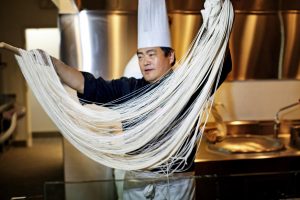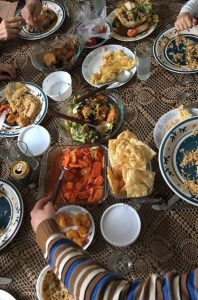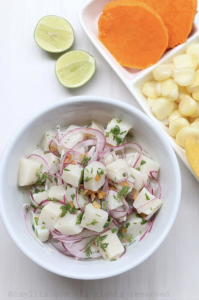Abstract: Latin America is a region heavily impacted by historical events that have led to a wide diversification of people (Oxford Reference, 2019). Despite mass erasures of cultures through the period of colonization and indentured servitude in Latin America, several aspects of these cultures have been persevered and have aided in the shaping of modern Latin America. This paper addresses the displacement of the Chinese people in Latin America since the mid 19th century (Chang-Rodríguez,1958). Specifically, the paper will analyze the Chinese diaspora and assimilation in Peru through the use of foods such as the noodle. Which has led to the creation of the unique Chinese-Peruvian culture that has impacted Peru’s culinary, social, and political history forever.
Through a western lens, we can understand Latin America to be one of the few regions only distinguished by an ethnicity (Latino/a/x) and not by a prevailing race. That is because Latin America has been widely impacted by its indigenous civilizations, European colonization, the Atlantic slave trade, migrations of Asian indentured servants, etc, (Oxford Reference, 2019). As described by Dr. Fernandez of Harvard University, the word Latino serves as a category for anyone from Latin America or of Latin American descent to be classified under, regardless of race or other ethnic backgrounds (Fernandez, 2018). Unfortunately, there is a tendency for many Latin Americans to erase the entirety of their ethnic backgrounds by only preserving the European aspects. There is a preference for European looks and heritage in Latina America, that impacts the stories and history you hear about your own people. Despite this, the wide categorization of Latin Americans is in part due to the resulting ambiguity of many years of intermixing between different races/ethnicity groups.
This diversification of people has a long and rather unpleasant history in Latin America. By the end of the slave trade there were approximately 12.5 million Africans taken to the Americas, where only about 400,000 African slaves made it to the U.S. and the remaining 10.5 million that survived were taken to Latin America and the Caribbean (Gates, 2012). A startling statistic that not many people associate with the founding of current Latin America. This migration of people has impacted every aspect of Latin American culture such as cuisine, music, dance, religion, and even down to the different uses of the Spanish language. I bring this up to highlight, that despite these mass erasures of cultures that occurred during periods of colonization such as Spanish settling in what is now known as the Philippines that led to trade with South America, some original practices and traditions of the original cultures still remain prevalent (Chang-Rodríguez,1958).
When zooming in on Asian history in Latin America we can think of a couple major countries. During the 19th century, the prosperity of the tea industry was introduced to Brazil leading to a migration of expert tea workers from China, forming “the first organized Asiatic colony in the New World” (Chang-Rodríguez,1958). Inner turmoil within Latin America, due to the end the slave trade and crippling economic systems from Spanish rule, countries in Latin America saw a need for indentured servants. Contracted from China some of the first indentured servants arrived in Cuba in 1847, many of whom died or committed suicide on the voyage. (Chang-Rodríguez,1958). Similarly, Peru suffered a great labor shortage due to a decrease in population and lack of contribution to labor forces by indigenous people. Peru opened up it’s legislation to encourage foreigners to move to the country’s Amazonian region by offering them privileges in exchange for work. This 1849 immigration law was the foundation for thousands of Chinese settlements in Peru (Chang-Rodríguez,1958).
Unfortunately, several cases occurred where many indentured servants were taken in inhumane conditions from China to work in Peru. By the end of the 19th century more than 100,000 Chinese indentured laborers arrived in Peru (Lausent-Herrera, 2009). Many of whom were men and their contracts did not allow them to have contact with local women, however, larger cities such as Lima were many Chinese laborers “were employed as domestic servants… [had] greater liberty” leading to more mixed-race births (Lausent-Herrera, 2009). Years of discriminatory practices against Chinese people in the U.S. and other countries, made Lima, Peru stand out because the “Hispanic cultural tradition does not emphasize racial difference” (Wong, 2009). Despite there still being subtle racism and discrimination, as mentioned prior there were no legal restrictions in Lima, on miscegenation between Chinese and Peruvian people, aiding in the assimilation of Chinese people and culture to what we know it to be in modern day Peru (Wong, 2009).
Nevertheless, life for Chinese Peruvians was very difficult, they had no recognition from their Chinese government and little from the Peruvian government. Torn between two worlds, Chinese Peruvians were looked down upon by native Chinese people for being “half-bloods” and they were not represented in Peru for being of Asian descent (Lausent-Herrera, 2009). During the mid to late 1900s, many Peruvian Chinese people were unsure to return to China or to stay in Peru. Both countries were facing issues with communist dictatorship like regimes, however, Peru for some Chinese people provided a way to be protected by what was occurring in mainland China while conditions bettered for Peru with the return of democracy in 1980 (Lausent-Herrera, 2009). During this time, the Chinese Peruvian culinary scene began to flourish because new Chinese cooks whom were less conservative began creating new dishes that preserved and emphasized the “creole Chinese cuisine special to Peru” (Lausent-Herrera, 2009).
According to the Overseas Community Affairs Council,Republic of China, Peru is currently the Latin American country with the highest population of Chinese people and ranks 7th overall in the world for largest population of Chinese people outside of China, 1.3 million Chinese Peruvians (OCAC, R.O.C., 2005). Despite prior negative Chinese-Peru relations, this large population of Chinese people in Peru has widely shaped Peru’s culinary history. Contributing to one of the most unique and diverse food fusions, the Peru-Chinese creation of Chifa, Chinese-Peruvian cuisine. In Peru there are local restaurants known as Chifas that serve the Chinese-Peruvian cuisine known as Chifa. Chifas have become as an easier way for Chinese immigrants to spend quality time with their families because “the circulation of information concerning the family and commercial activities no longer depends on institutions” in Peru but on these Chifas (Wong& Tan, 2013). Which served as a place to continue Chinese practices, communal gatherings, gaming centers, and as a means for bringing Peruvian and Chinese people together (Wong & Tan, 2013).
Chifa serves as a sort of symbol of the amalgamation between Peru and China. A necessity for Chinese-Peruvians who felt betrayed by the lack of recognition from the Chinese government, as well as out of place in a country with majority mestizo mix of European and Indigenous people. Leaving Chinese-Peruvians in their own category in which they had to learn to maneuver and reconstruct a new Ethnic group with similar yet different practices and traditions. Preserving their culture, Chinese immigrants in Peru still held on to their culinary traditions and learned of ways to combine them with regional spices and existing food practices already home to Peru. Birthing fusion dishes such as Arroz Chaufa (Cantonese-Peruvian Fried Rice), Tallarin Saltado (Cantonese-Peruvian Chow Mein), Wanton Frito (Fried Wonton), and Lomo Saltado (Beef and vegetable stir-fry).
Moreover, what is unique about Peruvian-Chinese food is that it is fully immersed in the culture of Peru. In the U.S. we think of different ethnic foods to be separate from American food, we think of Mexican food being solely Mexican and Chinese food being solely Chinese. However, in Peru because Chifa comes from the blend of Peruvian and Chinese cultures it is thought to be entirely Peruvian in origin. Much like there is little racial distinction amongst Latin Americas, that applies to all aspects including food which is just broadly defined as the region where the food originated. Peruvians have accepted and adopted many Chinese traditions in their own lives when it comes to food, serving as a source of comfort for a Chinese-Peruvians who felt a sense of displacement (Lausent-Herrera, 2009).
Peru-Chinese history is best told through immigration stories and through the use of anthropological data collection methods, such as interviews. Many of these stories are woven into the food and dishes that have emerged from such a blending of cultures. Such as that of BuzzFeed’s Stantos Loo, who is of Chinese Peruvian descent. Santos shares a touching story of his grandfather emigrating to Peru from Guangzhou and opening up a Chifa restaurant. While sharing this story he is also making a dish from his grandfather’s original menu, Chaufa de Marisco’s which is essentially a fried rice dish with mussels. Santo’s goes on to explain that this dish represents his heritage stating that he is a blend of Peruvian and Chinese cultures. He metaphorically describes the combination of ingredients in the wok as a merging of two cultures. The dish uses both Chinese and Peruvian ingredients to make a totally new cuisine. Such as the mixing of aji amarillo, which is a Peruvian chili pepper. As Santos puts it “Peru meets China” with the additions of soy sauce, oyster sauce, and sesame oil to the dish (Loo, 2019). Traditionally, these dishes are served in large bowls with the intention of everyone to share, which is another ethnically Chinese derived practice.
There are several noodle dishes in Peru with Chinese origin, known broadly as tallarin which are made of yellow egg noodles. The tallarins come in many varieties such as Cantonese-Peruvian Chow Mein style, or aeropuerto which is a mix of chow mein and fried rice dish. There are also wonton soup dishes known as sopa wonton and styles of fried wonton known as wonton frito. In the Journal of Ethnic foods article noodles are described to be a “reflection [of] cultural traditions and customs in China” and are even described to mean “human nature” implying that noodles are obviously embedded within everyday life for Chinese people (Zhang & Guansheng, 2016). Many noodles signifying something just beyond the necessary nourishment and are used in different traditions such as the longevity noodle which is eaten on birthdays to signify a long life, as well as the consumption of dragon whisker noodles in anticipation of good weather (Zhang & Guansheng, 2016). For many Chinese Peruvians continuing to eat these noodle dishes is a method of cultural preservation and when combining the dishes with Peruvian styles of cuisine it is a means of validating and establishing the ethnic group of Chinese Peruvians.
Moreover, many of the Chinese migrants to Peru came from the Southeastern region of Guangdong, Macao, and Hong Kong bringing with them their Cantonese styles of music, art, language, and primarily cuisine. In the southern region of China, Guangzhou wonton noodles are widely popular, as well as in Hong Kong strained noodles, rickshaw noodles, and shrimp roe noodles (Zhang & Guansheng, 2016). Many of which have made their way into Peruvian tallarin styles of cuisine, although these dishes have not been exactly replicated. In addition to this, for Chinese people “cereal food… is the main source of energy for the human body” highlighting the importance noodles have in maintaining a “good diet tradition” (Zhang & Guansheng, 2016). The bringing of Cantonese style noodles to Peru demonstrates the importance of the noodle for Chinese people, being that out of all the cuisine in China several noodle dishes prevailed in the scene of Chinese-Peruvian Chifa. In fact, many restaurants in Peru have noodle manufacturers linked to them where they distribute noodles to local businesses, also observed in Peru is the appearance of wonton and stuffed breads such as mimbao “made and sold in the streets” (Lausent-Herrera, 2011).
In the “Crossing the Bridge” noodle story we learned that noodles are meant to provide the sustenance necessary to overcome a feat such as studying and the fat in the noodles also helps keep out the bad spirits. Although the story is a metaphor for the protecting and capabilities of noodles it comes to life in almost all Chinese immigrant stories. For indentured servants in Peru who endured poor quality of life and their predecessors who faced ethno-social adversity, noodles provided a source of nourishment, comfort and familiarity to Chinese laborers in their times of hardship. Many of the laborers relied heavily on food to uplift their spirts and as a means of economic improvement, they opened up restaurant’s around Lima. After time, there were so many restaurants concentrated in the area that it became known as the Barrio Chino or Chinatown (Lausent-Herrera, 2011). These Barrio Chinos gave Chinese-Peruvians a space to practice their traditions and currently Chinese festivals such as Chinese New Year and the Mid-Autumn festival are celebrated there (Asociación Peruano China, 2015). Also home to Barrio Chinos are many temples and oracles which provide a sense of belonging for Chinese-Peruvians in a home away from home manner (Cruz, 2010).
For Chinese migrants, there is a heavy importance tied to noodles as a means of expression and significance. The use of noodles makes its way into all culinary spheres as a symbol for cultural heritage and has persisted in Peru through 172 years of hardships associated with the displacement of Chinese-Peruvians. Serving as an entity that connects Chinese-Peruvians with their homeland as well as Chinese-Peruvians with their predecessors in Peru. The persistence of the Chinese noodles across the world stands as a testament for the tenacity of Chinese culture. Earlier in the paper, I made the note that although there have been many attempts to erase different cultures throughout history there are still parts of these cultures that remain, impacting the traditions and societies of adoptive lands. There are even instances of complete immersion where new cultures and spaces are created to accommodate the needs and traditions of these newly founded cultures, much like what occurred in Peru with Chinese-Peruvians.
The Chinese diaspora is one that is indistinguishable from the diaspora of the noodle, it’s widespread popularity cannot be recognized or understood without the acknowledgment of the beautiful culture behind the production of the noodle. I have previously mentioned and still believe the noodle can be defined as a meal that has transcended cultural, linguistic, and international boundaries through its expression of care and love when prepared, served and consumed.
Bibliography
Ask a Scholar: What is the True Definition of Latino? by Dario Fernandez-Morera. (n.d.). Retrieved from https://www.nas.org/blogs/dicta/ask_a_scholar_what_is_the_true_definition_of_latino
African Slavery in Latin America and the Caribbean. By Herbert S. Klein and Ben Vinson III. 2 nd Edition. New York, NY: Oxford University Press, 2007. ISBN: 978-0195189421.
Bernard Wong and Tan Chee-Beng (2015). Chinatowns around the World: Gilded Ghetto, Ethnopolis, and Cultural Diaspora. International Sociology,30(5), 482-484. doi:10.1177/0268580915598098b
Calle Capon. Asociación Peruano China(2015). Retrieved from https://www.apch.com.pe/calle-capon.html
Chang-Rodríguez, Eugenio. “Chinese Labor Migration into Latin America in the Nineteenth Century.” Revista De Historia De América, no. 46, 1958, pp. 375–397. JSTOR, www.jstor.org/stable/20137297.
Clubb, J. (2018, October 16). Peruvian Chifa Cuisine in Lima’s Chinatown. Retrieved from https://www.rainforestcruises.com/jungle-blog/peruvian-chifa-cuisine-in-limas-chinatown
Cruz, J. (1970, January 01). El Oráculo. Retrieved from http://oraculodekuankong.blogspot.com/2010/02/el-oraculo.html
Gates, Jr., Henry Louis (2011). Black in Latin America. NYU. ISBN 9780814732984.
Lausent-Herrera, I. (2009). Tusans (tusheng) and the Changing Chinese Community in Peru. Journal of Chinese Overseas,5(1), 115-152. doi:10.1163/179325409×434522
Tasty. (2019, May 09). Chifa-Style Chaufa De Mariscos As Made By Santos Loo • Tasty. Retrieved from https://www.youtube.com/watch?v=8DappleWiqs
Wong, B. (1978). A Comparative Study of the Assimilation of the Chinese in New York City and Lima, Peru. Comparative Studies in Society and History, 20(3), 335-358. doi:10.1017/s0010417500009038
OCAC, R.O.C., (2005). (n.d.). Retrieved from https://web.archive.org/web/20131123193905/http://www.ocac.gov.tw/english/public/public.asp?selno=1163&no=1163&level=B
(2012). Latin America. Oxford Reference. Retrieved 9 Aug. 2019, from https://www.oxfordreference.com/view/10.1093/acref/9780191736674.timeline.0001.





